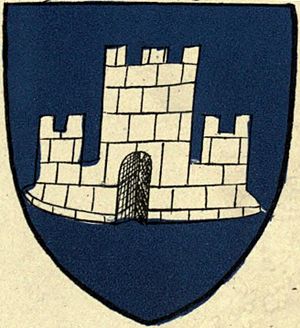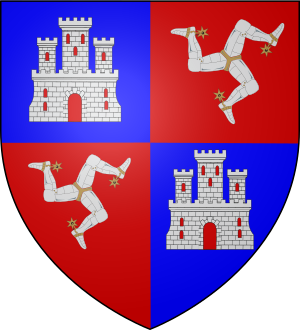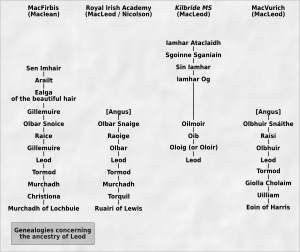Leod facts for kids
Quick facts for kids
Leod
|
|
|---|---|
| Born | c. 1200 |
| Died | 1280 |
| Resting place | Iona (according to tradition) |
| Known for | The 1st Chief of Clan MacLeod |
| Successor | Tormod (son) |
| Children | at least one son (several sons and daughters according to tradition) |
| Relatives | Foster son of Páll Bálkason (according to tradition) |
Leod (born around 1200, died 1280) was the person who started the famous Clan MacLeod and Clan MacLeod of Lewis. His name in Scottish Gaelic is Leòd and in Old Norse, it's Ljótr. We don't know much about him because he isn't mentioned in any old records from his time.
For a long time, people believed he was the son of Olaf the Black, who was a king of the Isle of Man in the 1200s. This idea came from family symbols (heraldry) used in the late 1600s. But recently, historians have questioned this story.
According to Clan MacLeod stories, Leod got some of his land from his foster father. This foster father was a sheriff on the Hebridean island of Skye. Leod also got more land from his father-in-law, who was also a lord on Skye. Clan stories say Leod had four sons and two daughters. Two of his sons, Tormod and Torquil, started the two main parts of the MacLeod clan that still exist today. Tormod's family became the MacLeods of Harris and Dunvegan. Torquil's family became the MacLeods of Lewis. However, it's now thought that Torquil was Leod's great-grandson, not his son.
Recent DNA tests on men with the MacLeod surname show that many share a common ancestor. This ancestor is believed to be the clan's founder.
Contents
Who Was Leod's Family?
Leod is known as the person who started the MacLeod clan. But we know very little about him. He doesn't appear in any old records from his time. The first time a MacLeod chief is mentioned in history is almost 100 years after Leod lived. This was when "Malcolme, son to Tormode M'Cloyde" and "Torkyll M'Cloyd" were named in a royal document around the 1300s.
Until recently, most people thought Leod was the son of Olaf the Black. Olaf was the King of Mann and the Isles from 1225 to 1237. This idea that Leod came from Olaf the Black started in the late 1600s. At that time, a chief named Iain Mòr MacLeod used the name "McOlaus," which means "son of Olaf." Later, his son Iain Breac was the first MacLeod to put the Manx triskelion symbol on his coat of arms. The triskelion was used by the kings of Mann and the Isles since the 1200s.
However, the oldest known MacLeod family symbols (from the mid-1400s) look very different from the Manx royal symbols. This suggests that the idea of being related to Olaf wasn't very old in the 1600s.
There are other reasons to doubt Leod's traditional family tree. For example, the last king of the Manx dynasty died in 1265. His son died in 1275 while leading a revolt. Later, two women tried to claim the kingdom, but Leod and his sons did not. Historians find it hard to believe that a royal family member wouldn't try to claim the throne. Also, the MacLeods didn't use the royal names of the 13th-century Manx kings. Names like Godfrey, Ranald, Olaf, and Harald were common in that royal family.
In the 1600s, a historian named George Mackenzie wrote that Leod was the son of Harald. Harald was the son of Godred Donn. But later family histories said Leod was the son of Olaf the Black. These later histories were written in the late 1700s and early 1800s. They claimed their information came from old books like the Chronicles of Mann. However, neither of these old books mentions Leod at all. In 1977, historian William Matheson said that the story of Leod being Olaf the Black's son was not true. He said there were no facts to support it.
Old Family Trees Re-examined
In recent years, historians have looked closely at old Gaelic family trees and poems about the MacLeods. They noticed that Leod's great-grandfather's name seems to be Ölvir or Olvér in Old Norse. It does not look like Óláfr (Olaf). There are four important Gaelic family trees that talk about Leod's ancestors. These trees mostly agree on the names of the three generations after Leod. The biggest similarity is the name of Leod's great-grandfather. It's spelled in different ways, but they all seem to mean Olbhar or Olghair in Gaelic, which comes from Ölvir.
One idea is that when a book about the kings of Mann was published, people saw the Latin name Olavus (a form of Olaf). They mistakenly thought it was the Gaelic name Olbhar. But the correct Gaelic name for Olaf is Amhlaoibh. So, historians think that people wrongly connected Leod's father and great-grandfather to King Olaf the Black and his grandfather, Olaf the Red. While historians now agree on the name of Leod's great-grandfather, there's still some debate about his father's name.
Leod's name, Leòd in Scottish Gaelic, comes from the Old Norse word Ljótr, which means "ugly." This name was rare in Scandinavia and Iceland. It was mostly found among the MacLeods in Scotland. Some historians thought Leod's great-grandfather might have been a person named Olvir Rosta from an old saga. But other historians say there's not enough proof for this idea.
Leod in Clan Stories
Stories from Other Clans
An old family history from the 1600s, written by the Earl of Cromartie, says Leod was the son of Harald. It says that when the Isle of Man became part of Scotland, King Alexander III gave lands like Lewis and Harris to Harald. Leod then inherited these lands from his father. This story also says Leod's wife was Adama, daughter of the Earl of Ross. However, historians say there are no records to support any of these claims. They believe these parts of the story were made up.
Another old document, about the Rosses, also mentions Leod. It says a King of Denmark had three sons who came to Scotland. One son, Loid, took over Lewis and became the ancestor of the MacLeods.
Clan MacLeod's Own Stories
According to a MacLeod story from 1797, Olaf the Black had three sons. One of them was Leod. The story says Leod was raised by "Pol, son of Bok," who was a sheriff on Skye. This Pol then gave Leod the island of Harris. Later, Leod married a daughter of "McCraild Armuinn" and received Dunvegan and other lands on Skye.
This "Pol, son of Bok" is thought to be the same person as Páll, son of Bálki, who was a loyal friend of Olaf the Black. The story says Paal Baccas (Pol) died in 1231, and Leod then took over his lands peacefully.
An important old document called the Bannatyne manuscript is a main source for stories about the early MacLeod chiefs. It says the first seven chiefs were buried at Iona. In the middle of the choir at Iona Abbey, there's a large stone. This stone once held a metal plate and is traditionally said to be a MacLeod tomb. It's the biggest carved stone on the island. Some thought Leod and five of his family members were buried there. However, this stone might actually mark the tomb of a MacLean chief, not a MacLeod.
Leod's Children
MacLeod tradition says Leod had two sons: Tormod and Torquil. Tormod was said to be the ancestor of the MacLeods of Harris and Dunvegan. Torquil was said to be the ancestor of the MacLeods of Lewis. For a long time, people debated which son was older. However, modern historians now believe Tormod and Torquil were not brothers. Instead, Torquil was likely Tormod's grandson.
The Bannatyne manuscript also names two other sons: John and Olaus. But this manuscript is the only source for these names. It says John went to Ireland with Robert the Bruce and became a knight. His descendants were called MacElliots. This part of the story has some timeline issues, as John's daughter would have married before Bruce went to Ireland. The manuscript says Olaus was the ancestor of the MacLewis or Fullarton family.
The manuscript also mentions that Leod had two daughters, but it doesn't give their names. It says one married Fergus of Galloway and the other married John, Lord of Mull. We don't know who these men might have been.
DNA and the Clan's Origin
In 2011, scientists did DNA tests on 45 men with the MacLeod surname. They found that 47% of them shared a common ancestor on their father's side. This means they came from the same male family line. This specific genetic marker is found in places like the Western Isles, Orkney, Shetland, England, Norway, and Sweden. Because of this, the study suggests that the MacLeod clan likely has its roots in Scandinavia (Northern Europe).
See also
- Coat of arms of the Isle of Man, a description of the symbols used by the Lords/Kings of Mann.
- Ljótólfr, a character from old stories linked to Lewis, once thought to be an ancestor of the MacLeods.
- Léot of Brechin
- MacLeòid






